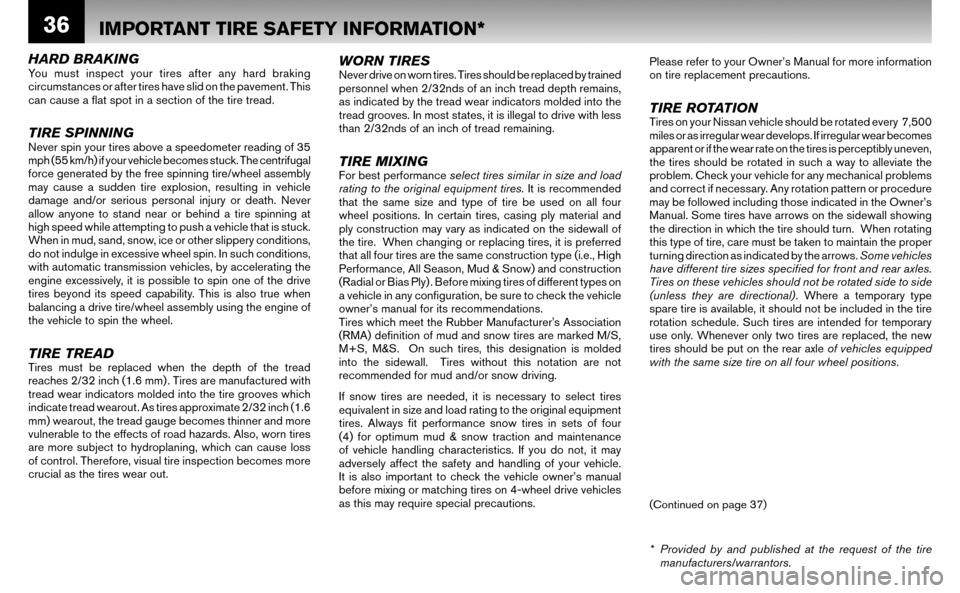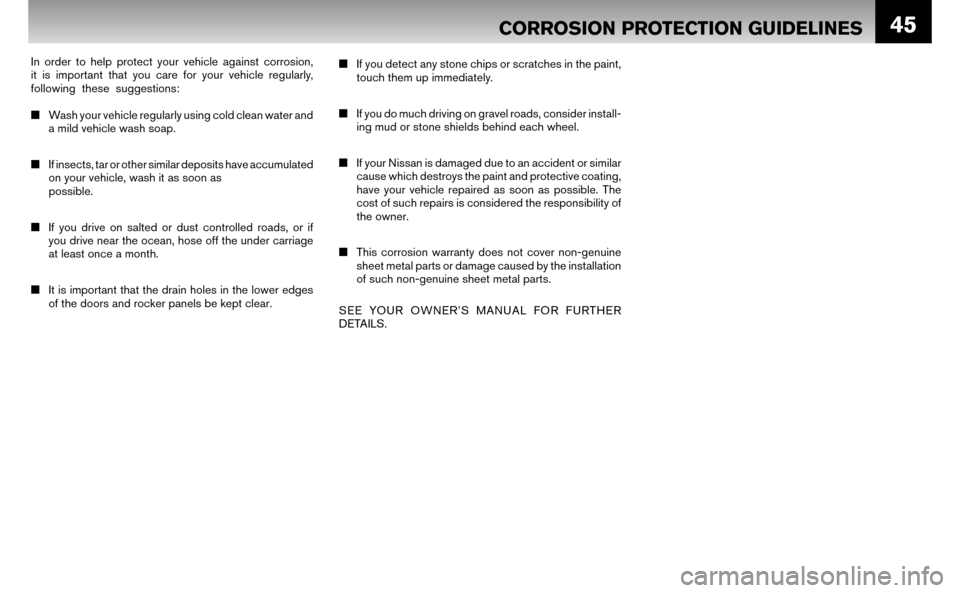2008 NISSAN ALTIMA HYBRID wheel
[x] Cancel search: wheelPage 40 of 54

36
HARD BRAKINGYou must inspect your tires after any hard braking
circumstances or after tires have slid on the pavement. This
can cause a fl at spot in a section of the tire tread.
TIRE SPINNINGNever spin your tires above a speedometer reading of 35
mph (55 km/h) if your vehicle becomes stuck. The centrifugal
force generated by the free spinning tire/wheel assembly
may cause a sudden tire explosion, resulting in vehicle
damage and/or serious personal injury or death. Never
allow anyone to stand near or behind a tire spinning at
high speed while attempting to push a vehicle that is stuck.
When in mud, sand, snow, ice or other slippery conditions,
do not indulge in excessive wheel spin. In such conditions,
with automatic transmission vehicles, by accelerating the
engine excessively, it is possible to spin one of the drive
tires beyond its speed capability. This is also true when
balancing a drive tire/wheel assembly using the engine of
the vehicle to spin the wheel.
TIRE TREADTires must be replaced when the depth of the tread
reaches 2/32 inch (1.6 mm) . Tires are manufactured with
tread wear indicators molded into the tire grooves which
indicate tread wearout. As tires approximate 2/32 inch (1.6
mm) wearout, the tread gauge becomes thinner and more
vulnerable to the effects of road hazards. Also, worn tires
are more subject to hydroplaning, which can cause loss
of control. Therefore, visual tire inspection becomes more
crucial as the tires wear out.
WORN TIRESNever drive on worn tires. Tires should be replaced by trained
personnel when 2/32nds of an inch tread depth remains,
as indicated by the tread wear indicators molded into the
tread grooves. In most states, it is illegal to drive with less
than 2/32nds of an inch of tread remaining.
TIRE MIXINGFor best performance select tires similar in size and load
rating to the original equipment tires. It is recommended
that the same size and type of tire be used on all four
wheel positions. In certain tires, casing ply material and
ply construction may vary as indicated on the sidewall of
the tire. When changing or replacing tires, it is preferred
that all four tires are the same construction type (i.e., High
Performance, All Season, Mud & Snow) and construction
(Radial or Bias Ply) . Before mixing tires of different types on
a vehicle in any confi guration, be sure to check the vehicle
owner’s manual for its recommendations.
Tires which meet the Rubber Manufacturer's Association
(RMA) defi nition of mud and snow tires are marked M/S,
M+S, M&S. On such tires, this designation is molded
into the sidewall. Tires without this notation are not
recommended for mud and/or snow driving.
If snow tires are needed, it is necessary to select tires
equivalent in size and load rating to the original equipment
tires. Always fi t performance snow tires in sets of four
(4) for optimum mud & snow traction and maintenance
of vehicle handling characteristics. If you do not, it may
adversely affect the safety and handling of your vehicle.
It is also important to check the vehicle owner’s manual
before mixing or matching tires on 4-wheel drive vehicles
as this may require special precautions. Please refer to your Owner’s Manual for more information
on tire replacement precautions.
TIRE ROTATIONTires on your Nissan vehicle should be rotated every 7,500
miles or as irregular wear develops. If irregular wear becomes
apparent or if the wear rate on the tires is perceptibly uneven,
the tires should be rotated in such a way to alleviate the
problem. Check your vehicle for any mechanical problems
and correct if necessary. Any rotation pattern or procedure
may be followed including those indicated in the Owner’s
Manual. Some tires have arrows on the sidewall showing
the direction in which the tire should turn. When rotating
this type of tire, care must be taken to maintain the proper
turning direction as indicated by the arrows.
Some vehicles
have different tire sizes specifi ed for front and rear axles.
Tires on these vehicles should not be rotated side to side
(unless they are directional) . Where a temporary type
spare tire is available, it should not be included in the tire
rotation schedule. Such tires are intended for temporary
use only. Whenever only two tires are replaced, the new
tires should be put on the rear axle of vehicles equipped
with the same size tire on all four wheel positions .
* Provided by and published at the request of the tire manufacturers/warrantors.
IMPORTANT TIRE SAFETY INFORMATION*
(Continued on page 37)
Page 41 of 54

37
TRAILER TOWINGIf you anticipate towing a trailer, you should see a tire dealer
for advice concerning the correct size of tire and pressure.
Tire size and pressure will depend on the type and size
of the trailer and hitch utilized, but in no case must the
maximum cold infl ation pressure or the tire load rating be
exceeded. Check the tire decal and your Owner’s Manual
for further recommendations on trailer towing.
TIRE ALTERATIONSDo not perform any alterations on your tires. Alterations may
prevent proper performance, leading to tire damage, which
can result in an accident. Tires which become unserviceable
due to alterations such as truing, whitewall inlays, addition
of balancing or sealant liquids, may be excluded from
warranty coverage. Consult your tire warranty.
HIGH PRESSURE TEMPORARY SPARE
TIRES
1) The high-pressure spare tire in your Nissan vehicle is designed for temporary use only and must not be used
continually as a regular tire. The standard tire should
be repaired and/or replaced as soon as possible.
2) Avoid driving over obstacles that may damage the tire through impact or cutting, such as potholes, glass,
metal, etc. 3) Speed must not exceed 50MPH (80km/h) for non-
speed-rated temporary spare tires.
4) Temporary spare tires have a limited treadlife which can vary depending on road conditions and your
driving habits. The spare tire should be returned to
the trunk as soon as the standard tire can be repaired
or replaced.
5) Because the high-pressure spare tire was specifi cally designed for your car, it should not be used on any
other vehicle.
6) Do not use snow chains on your high-pressure spare.
This could cause damage to your vehicle.
7) Check the tire’s cold infl ation pressure monthly and maintain at 60psi (4.2kg/cm
2) even when not in
use.
8) The high-pressure spare tire should not be used with any other rim nor should standard tires, wheel covers,
or trim rings be used on the high-pressure spare tire
rim which was originally installed.
9) When the tread wear indicator appears on the tire, replace it only with the same type spare tire.
10) Do not enter an automatic carwash with a temporary spare tire fi tted.
11) Do not make a sharp turn or apply the brakes suddenly when driving on a high-pressure temporary spare.
Note: When using any temporary type spare tire, be sure to
follow the vehicle Owner’s Manual instructions.
TIRE STORAGEAll tires should be stored in a cool dry place indoors so that
there is no danger of water collecting inside them.
When tires are stored they should be stored in a cool place
away from sources of heat and ozone such as hot pipes
and electric generators. Be sure that surfaces on which
tires are stored are clean and free from grease, gasoline
or other substances which could deteriorate the rubber.
(Tires exposed to these materials during storage or driving
could be subject to sudden failure.)
To Avoid Damage to your Tires and
Possible Accident:
• Check tire pressure at least once a month when
tires are cold and before long trips.
• Do not underinfl ate/overinfl ate.
• Do not overload.
• Drive at moderate speeds, observe legal limits.
• Avoid driving over potholes, obstacles, curbs or
edges of pavement.
• Avoid excessive wheel spinning.
• If you see any damage to a tire, replace with spare
and see the tire manufacturer’s dealer or your
Nissan dealership.
For further information, the Consumer Tire Guide on
passenger tire care, safety and mileage performance is
available in the United States by writing the Tire Industry
Safety Council, Box 1801, Washington, D.C. 20013.
* Provided by and published at the request of the tire manufacturers/warrantors.
IMPORTANT TIRE SAFETY INFORMATION*
Page 49 of 54

45
In order to help protect your vehicle against corrosion,
it is important that you care for your vehicle regularly,
following these suggestions:
■ Wash your vehicle regularly using cold clean water and a mild vehicle wash soap.
■ If insects, tar or other similar deposits have accumulated on your vehicle, wash it as soon as
possible.
■ If you drive on salted or dust controlled roads, or if you drive near the ocean, hose off the under carriage
at least once a month.
■ It is important that the drain holes in the lower edges of the doors and rocker panels be kept clear. ■
If you detect any stone chips or scratches in the paint,
touch them up immediately.
■ If you do much driving on gravel roads, consider install-
ing mud or stone shields behind each wheel.
■ If your Nissan is damaged due to an accident or similar
cause which destroys the paint and protective coating,
have your vehicle repaired as soon as possible. The
cost of such repairs is considered the responsibility of
the owner.
■ This corrosion warranty does not cover non-genuine
sheet metal parts or damage caused by the installation
of such non-genuine sheet metal parts.
SEE YOUR OWNER’S MANUAL FOR FURTHER
DETAILS.
CORROSION PROTECTION GUIDELINES